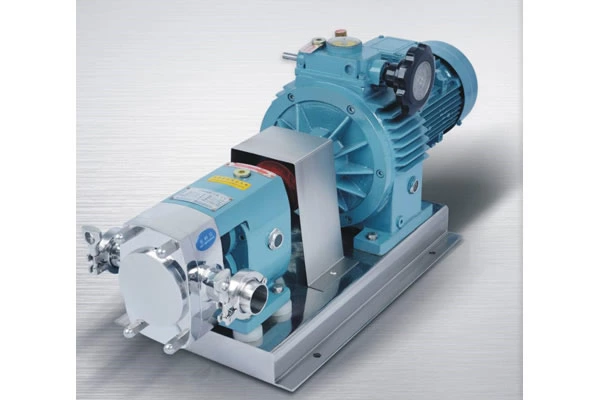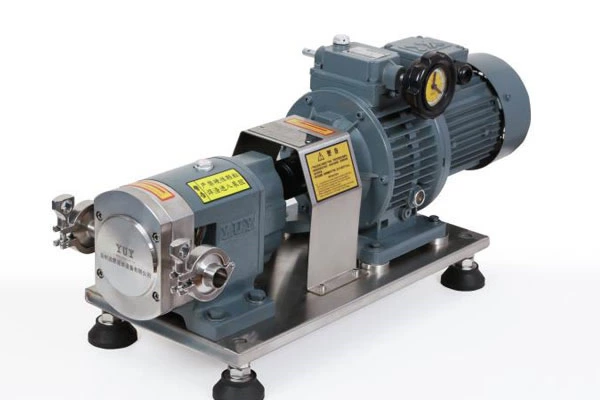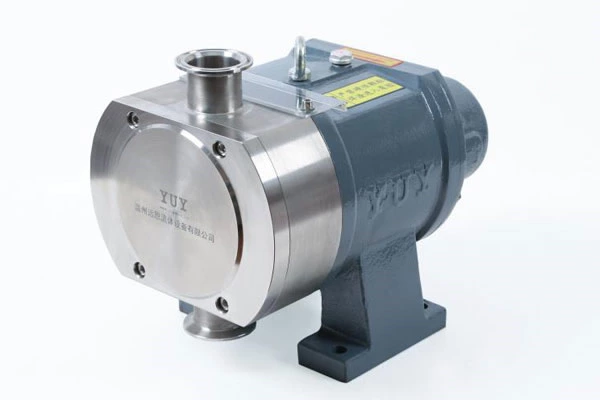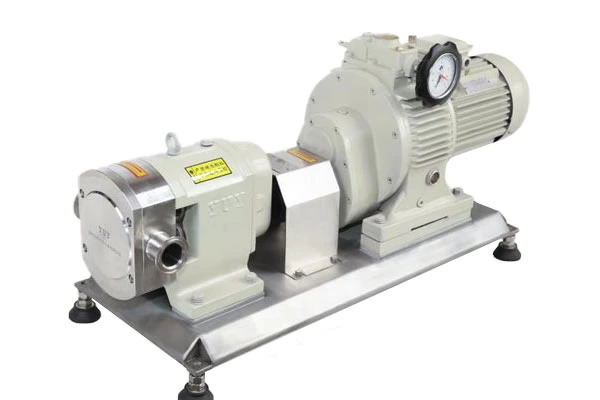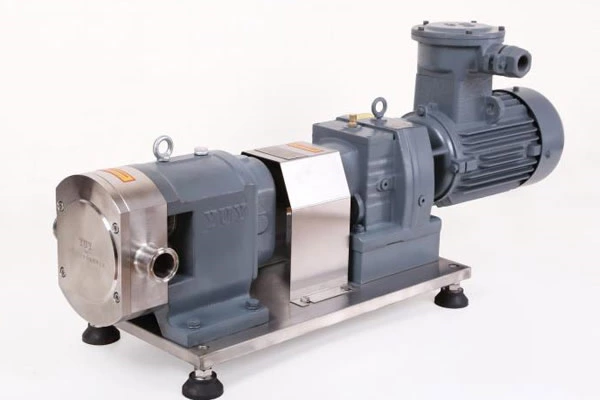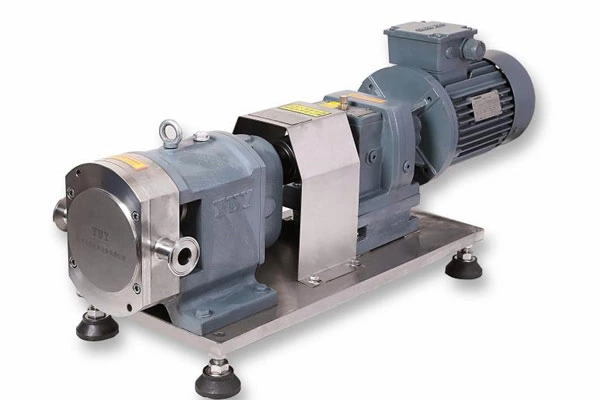Selection Analysis Of Sanitary Rotary Vane Pump
The petrochemical industry occupies a very important position in the national economy, and Sanitary Rotary Lobe Pump as a key supporting equipment has also attracted more and more attention. Due to the complex characteristics of chemical media and the continuous improvement of user requirements, as a manufacturer, how should we select? What aspects should we focus on? ... etc. are particularly important. Now, combined with the characteristics of the company's related products and my superficial understanding, I will make a brief comment on the selection of commonly used sanitary rotary vane pumps, hoping to help colleagues to better carry out work in this field.
Corrosion resistance
For a long time, corrosion has been one of the most troublesome hazards of chemical equipment. If you are not careful, it will damage the equipment at the least, and cause accidents or even disasters at the worst. According to relevant statistics, about 60% of the damage to chemical equipment is caused by corrosion. Therefore, when selecting sanitary rotary vane pumps, you must first pay attention to the scientific nature of material selection. There is usually a misunderstanding that stainless steel is a "universal material". It is very dangerous to use stainless steel regardless of the medium and environmental conditions. The following is a discussion of the key points of material selection for some commonly used chemical media:
1. Sulfuric acid As one of the strong corrosive media, sulfuric acid is an important industrial raw material with a wide range of uses. Sulfuric acid of different concentrations and temperatures has a great difference in the corrosion of materials. For concentrated sulfuric acid with a concentration of more than 80% and a temperature of less than 80°C, carbon steel and cast iron have good corrosion resistance, but they are not suitable for high-speed flowing sulfuric acid and are not suitable for use as pump and valve materials; ordinary stainless steel such as 304 (0Cr18Ni9) and 316 (0Cr18Ni12Mo2Ti) are also limited in use for sulfuric acid media. Therefore, pumps and valves for conveying sulfuric acid are usually made of high-silicon cast iron (difficult to cast and process) and high-alloy stainless steel (Alloy 20). Fluoroplastics have good resistance to sulfuric acid, and using fluorine-lined pumps (F46) is a more economical choice.
2. Hydrochloric acid Most metal materials are not resistant to hydrochloric acid corrosion (including various stainless steel materials), and molybdenum-containing high-silicon iron can only be used for hydrochloric acid below 50°C and 30%. In contrast to metal materials, most non-metallic materials have good corrosion resistance to hydrochloric acid, so lined rubber pumps and plastic pumps (such as polypropylene, fluoroplastics, etc.) are the best choices for conveying hydrochloric acid.
3. Nitric acid Most metals are rapidly corroded and destroyed in nitric acid. Stainless steel is the most widely used nitric acid-resistant material and has good corrosion resistance to nitric acid of all concentrations at room temperature. It is worth mentioning that stainless steel containing molybdenum (such as 316, 316L) is not only not better than ordinary stainless steel (such as 304, 321) in corrosion resistance to nitric acid, but sometimes even worse. For high-temperature nitric acid, titanium and titanium alloy materials are usually used.
4. Acetic acid It is one of the most corrosive substances among organic acids. Ordinary steel will be severely corroded in acetic acid of all concentrations and temperatures. Stainless steel is an excellent acetic acid-resistant material. Molybdenum-containing 316 stainless steel can also be used for high temperature and dilute acetic acid vapor. For high temperature and high concentration acetic acid or other corrosive media and other harsh requirements, high alloy stainless steel or fluoroplastic pumps can be selected.
5. Alkali (sodium hydroxide) Steel is widely used in sodium hydroxide solutions below 80°C and within 30% concentration. There are also many factories that still use ordinary steel at 100°C and below 75%. Although corrosion increases, the economy is good. Ordinary stainless steel has no obvious advantage over cast iron in corrosion resistance to alkali solution. As long as a small amount of iron is allowed to be added to the medium, stainless steel is not recommended. Titanium and titanium alloys or high-alloy stainless steel are often used for high-temperature alkali solution. The company's general cast iron pumps can be used for low-concentration alkali solution at room temperature. When special requirements are required, various types of stainless steel pumps or fluoroplastic pumps can be used.
6. Ammonia (ammonia hydroxide) Most metals and non-metals are slightly corroded in liquid ammonia and ammonia water (ammonia hydroxide). Only copper and copper alloys are not suitable for use. Most of the company's products are suitable for the transportation of ammonia and ammonia water.
7. Salt water (seawater) The corrosion rate of ordinary steel in sodium chloride solution, seawater and salt water is not very high, and generally requires coating protection; various types of stainless steel also have a very low uniform corrosion rate, but may cause local corrosion due to chloride ions. It is usually better to use 316 stainless steel.
8. Alcohols, ketones, esters, ethers Common alcohol media include methanol, ethanol, ethylene glycol, propanol, etc., ketone media include acetone, butanone, etc., ester media include various methyl esters, ethyl esters, etc., ether media include methyl ether, ethyl ether, butyl ether, etc. They are basically non-corrosive and can be used with common materials. When selecting, reasonable choices should be made based on the properties of the media and relevant requirements. In addition, it is worth noting that ketones, esters, and ethers are soluble in a variety of rubbers, so avoid mistakes when selecting sealing materials.
There are many other media that cannot be introduced here one by one. In short, you must not be arbitrary and blind when selecting materials. You should refer to relevant information or learn from mature experience.
Cooling problem
The transportation of high-temperature media puts higher requirements on the structure, materials and auxiliary systems of the pump. Let's talk about the requirements for cooling under different temperature changes and the applicable pump types of the company:
1. For media with a temperature below 120°C, a special cooling system is usually not set up, and the medium itself is often used for lubrication and cooling.
2. For media above 120℃ and within 300℃, a cooling chamber should be provided on the pump cover, and the sealing chamber should also be connected to the coolant (double-end mechanical seal is required). When the coolant is not allowed to penetrate into the medium, the medium itself should be cooled before being connected (which can be achieved through a simple heat exchanger).
3. For high-temperature media above 300℃, not only the pump head needs to be cooled, but the suspension bearing chamber should also be equipped with a cooling system. The pump structure is generally a central support form, and the mechanical seal is preferably a metal bellows type, but the price is high (the price is more than 10 times that of ordinary mechanical seals).
Sealing problem
No leakage is the eternal pursuit of chemical equipment. It is this requirement that has led to the increasing application of magnetic pumps and shielded pumps. However, there is still a long way to go to truly achieve no leakage, such as the life of the magnetic pump isolation sleeve and the shielding sleeve of the shielding pump, the pitting problem of the material, the reliability of the static seal, and so on. Here is a brief introduction to some basic information about sealing:
1. Sealing form For static sealing, there are usually only two forms: sealing pads and sealing rings, and O-rings are the most widely used sealing rings; for dynamic sealing, sanitary rotary vane pumps rarely use packing seals, and mainly use mechanical seals. Mechanical seals are divided into single-end and double-end, balanced and unbalanced types. The balanced type is suitable for sealing high-pressure media (usually refers to pressure greater than 1.0MPa). Double-end mechanical seals are mainly used for high-temperature, easy-to-crystallize, viscous, particle-containing and toxic volatile media. Double-end mechanical seals should inject isolation fluid into the sealing cavity, and its pressure is generally 0.07~0.1MPa higher than the medium pressure.
2. Sealing material The material of the static seal of the sanitary rotary vane pump is generally fluororubber, and polytetrafluoroethylene materials are used in special cases; the material configuration of the dynamic and static rings of the mechanical seal is more critical. It is not the best for cemented carbide to cemented carbide. The high price is one aspect, and it is not reasonable that there is no hardness difference between the two, so it is best to treat them differently according to the characteristics of the medium.
Viscosity problem
The viscosity of the medium has a great influence on the performance of the pump. When the viscosity increases, the pump head curve decreases, the head and flow rate of the best working condition decrease, and the power increases, so the efficiency decreases. The parameters on the general samples are the performance when conveying clean water. When conveying viscous media, conversion should be performed (the correction coefficients of different viscosities can be found in the relevant conversion chart).
